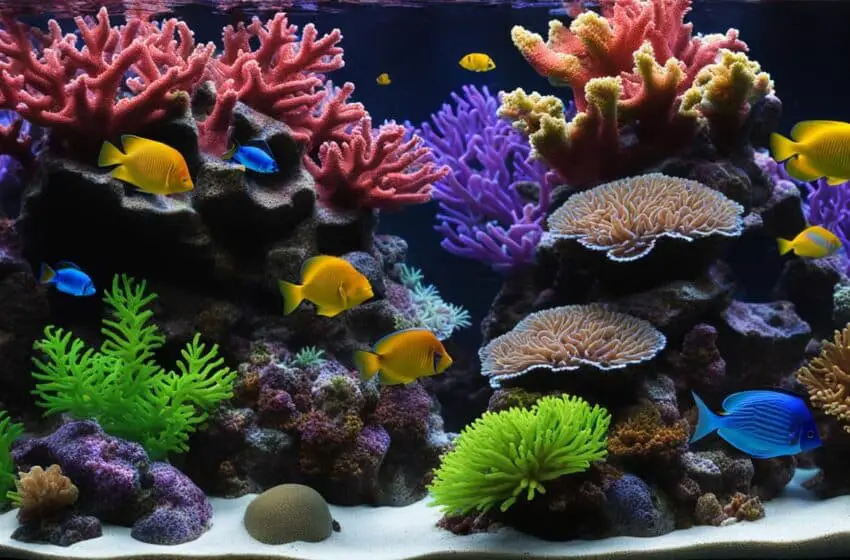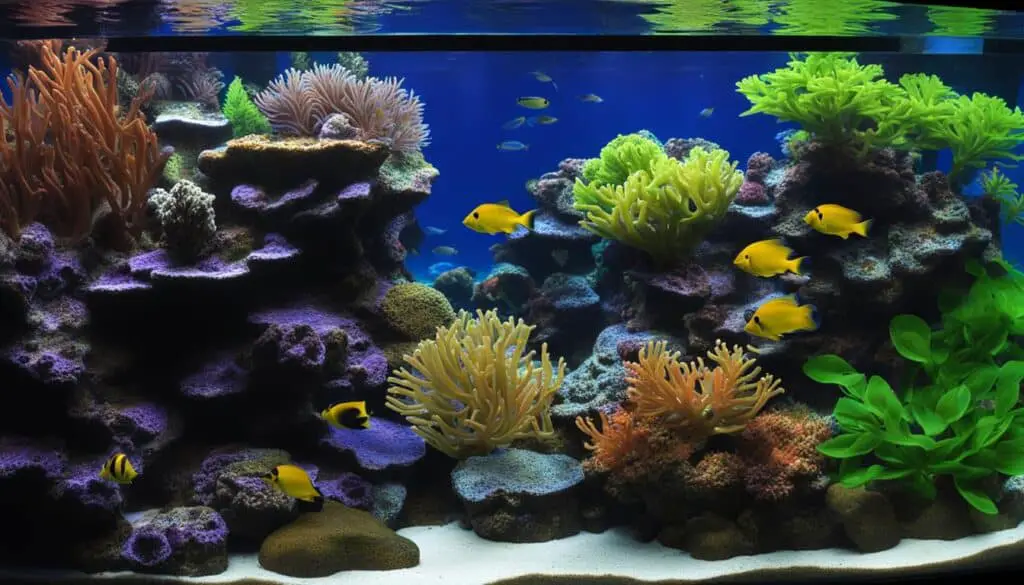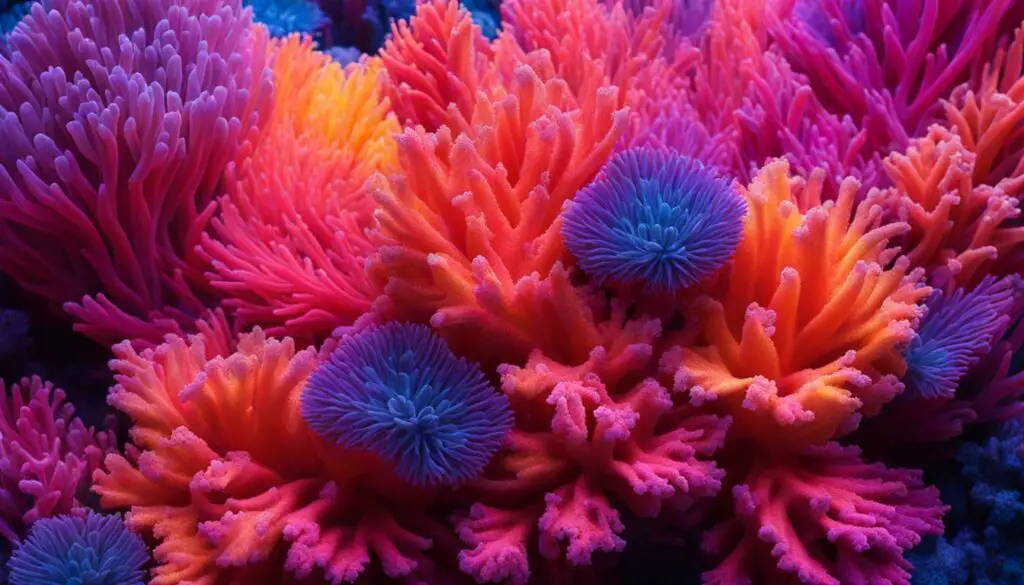Lighting Techniques for a Stunning Reef Aquarium Display

When it comes to creating a visually captivating and vibrant reef aquarium display, lighting plays a vital role. The right lighting techniques can enhance the beauty of your saltwater aquarium, promote coral growth, and create stunning coloration. In this saltwater aquarium lighting guide, I will discuss the key factors to consider when it comes to lighting your reef tank and share expert tips for achieving the best results.
Key Takeaways:
- Kelvin, Luminance, and PAR are the main factors to consider when lighting a reef aquarium.
- Aim for a Kelvin range between 5000K and 14000K for optimal color temperature.
- Maintain an ideal luminance range of 20-50 PAR for proper photosynthesis and coral growth.
- Ensure a Photosynthetically Active Radiation (PAR) range of 100-500 µmol·m^-2·s^-1.
- Proper lighting is essential for the health and growth of corals and other organisms in a reef aquarium.
The Importance of Lighting in a Reef Aquarium
Lighting plays a crucial role in the health and growth of corals and other organisms in a reef aquarium. Adequate light is necessary for proper photosynthesis and energy production, which fuels the growth and vibrant colors of corals. Insufficient light can result in reduced growth and bleaching of coral. It is important to create an ideal luminance level and provide the right amount of PAR for the specific needs of the corals and organisms in the aquarium.
Photosynthesis is a vital process for corals, as it allows them to convert light energy into chemical energy, providing the necessary nutrients for growth and survival. Light acts as the primary energy source for photosynthesis, driving the production of oxygen and organic compounds that are essential for coral growth.
Proper lighting conditions promote the synthesis of pigments responsible for the vibrant colors seen in corals. Coral pigments, such as chlorophyll and carotenoids, absorb different wavelengths of light, enhancing the visual appeal of the reef aquarium. Additionally, light intensity affects the growth pattern of corals, influencing their skeletal development and shape.
When selecting reef aquarium lighting, it is crucial to consider the specific light requirements of the corals and organisms in the tank. Different species have varying light sensitivity and adaptability, necessitating tailored lighting setups. It is essential to strike a balance between providing enough light for photosynthesis without exceeding the corals’ tolerance levels.
A well-designed lighting system should offer the appropriate spectrum, intensity, and duration to support optimal coral growth and coloration. The spectrum refers to the range of wavelengths emitted by the light source and influences the appearance and photosynthetic efficiency of corals. Intensity, measured in PAR (Photosynthetically Active Radiation), should be adjusted to meet the light requirements of the corals and promote healthy photosynthesis.
“The correct lighting conditions are crucial for the wellbeing and visual appeal of a reef aquarium. By providing the right amount and type of light, aquarists can create a stunning underwater ecosystem that fosters coral growth and showcases vibrant colors.”
– Dr. Robert Campbell, Marine Biologist
In summary, lighting is an essential component of a successful reef aquarium. It not only supports coral growth and photosynthesis but also enhances the visual beauty of the tank. Understanding the lighting needs of different coral species and providing the appropriate luminance and PAR levels is vital for creating a thriving and visually stunning reef aquarium.
Choosing the Right Lighting Fixtures for Your Reef Aquarium
When it comes to lighting your reef aquarium, selecting the right lighting fixtures is essential for the health and vitality of your corals and marine life. There are various options available in the market, each with its own advantages and considerations. LED lights, Kessil, Radion, Neptune, T5, and metal halides are some of the popular choices among reef tank enthusiasts.
LED lights, such as those from Kessil, Radion, Neptune, and AI, have gained popularity due to their energy efficiency, customizable spectrum, and long lifespan. These lights offer a wide range of colors and intensities, allowing you to simulate natural lighting conditions in your reef aquarium. They also produce minimal heat, reducing the risk of overheating your tank.
T5 fixtures are another commonly used option in reef aquarium lighting. These fluorescent lights provide uniform coverage and a broad spectrum of light, promoting healthy coral growth. T5 lights are available in different lengths, making them suitable for tanks of various sizes.
Metal halides, on the other hand, are powerful lights that can provide intense light penetration, perfect for deep tanks or tanks with light-demanding corals. However, they can generate a significant amount of heat and consume more electricity compared to LED lights or T5 fixtures.
When choosing the right lighting fixture for your reef tank, it is crucial to consider factors such as power needs, distribution needs, spectrum requirements, and schedule needs. Assess the specific requirements of your corals and organisms, as well as the aesthetic appeal you desire. You may also want to consider factors like energy efficiency and maintenance requirements.
Ultimately, the choice of lighting fixtures for your reef aquarium will depend on your personal preferences, budget, and the needs of your corals and marine life. It is advisable to research and consult with experts or experienced aquarists to make an informed decision.
Comparison of Reef Aquarium Lighting Fixtures
| Lighting Fixture | Advantages | Considerations |
|---|---|---|
| LED Lights (e.g., Kessil, Radion, Neptune, AI) | Energy-efficient, customizable spectrum, long lifespan | Higher initial cost |
| T5 Fixtures | Uniform coverage, broad spectrum | Fluorescent bulb replacement |
| Metal Halides | Intense light penetration, suitable for light-demanding corals | Higher heat generation, higher electricity consumption |
Creating a Lighting Schedule for Your Reef Aquarium
A well-designed lighting schedule is crucial for the overall dynamics of a reef aquarium. By implementing a proper lighting schedule, you can provide a stable environment and optimize the growth and health of your corals and organisms. The lighting schedule should be tailored to mimic natural lighting patterns and meet the specific needs of your underwater ecosystem.
For optimal results, it is recommended to follow a twelve-hour lighting cycle, which includes a two-hour ramp up, an eight-hour main photoperiod, and a two-hour ramp down. This cycle allows for a gradual transition between light and darkness, reducing stress and providing a more natural habitat for your marine life.
The ramp up period at the beginning of the lighting schedule gradually increases the intensity of the light, simulating the sunrise effect. This gentle transition helps to wake up your corals and prepares them for the main photoperiod. Similarly, the ramp down period mimics the sunset, gradually reducing the light intensity and signaling to your corals that it is time to rest.
During the main photoperiod, it is crucial to provide a balanced spectrum and intensity of light. This ensures proper photosynthesis and energy production for the corals’ growth and vibrant colors. Adjusting the spectrum to include wavelengths that promote photosynthesis and fluorescence can further enhance the visual appeal of your reef aquarium.
Some reef aquariums may benefit from a high noon “bump” to simulate the effect of metal halides. This involves increasing the light intensity for a few hours during midday, replicating the natural behavior of the sun at its highest point. This additional burst of light can contribute to accelerated coral growth and coloration.
Remember, each reef aquarium is unique, and the lighting schedule may need to be adjusted based on the specific needs of your corals and organisms. Regular monitoring of your aquarium’s inhabitants and their response to the lighting schedule is essential for fine-tuning and ensuring optimal conditions.

Tips for Creating a Lighting Schedule:
- Research the lighting requirements of your corals and organisms to determine their ideal photoperiod.
- Gradually introduce the light in the morning during the ramp up period to simulate sunrise.
- Provide a balanced spectrum of light throughout the main photoperiod.
- Consider incorporating a high noon “bump” for increased coral growth and coloration.
- Gradually decrease the light intensity in the evening during the ramp down period to simulate sunset.
- Regularly monitor your corals’ response to the lighting schedule and make adjustments as needed.
“A well-designed lighting schedule is the key to a thriving and visually captivating reef aquarium.” – [Author Name]
The Role of Light in Coloration of Reef Aquariums
Lighting plays a significant role in the coloration of corals and fish in a reef aquarium. The way we perceive colors is based on the reflection of specific light wavelengths by color pigments. However, there is an additional element that adds to the vibrant hues and stunning coloration seen in reef aquariums: fluorescence.
Fluorescent proteins present in corals play a crucial role in enhancing their colors. These proteins absorb high-energy blue-violet light and re-emit it at different wavelengths, resulting in a luminous visual effect. The combination of fluorescent proteins, color pigments, and light spectrums creates the mesmerizing and diverse colors that captivate aquarium enthusiasts.
To achieve the best fluorescence and color pop, it is essential to ensure a balanced light spectrum that includes peaks in the violet, blue, and indigo wavelengths. These wavelengths are particularly beneficial for activating the fluorescent proteins in corals, leading to a more vibrant and eye-catching appearance.
For a clearer understanding, let’s take a closer look at the light spectrum and its impact on the coloration of reef aquariums:

| Light Wavelength | Color Pigments | Resulting Color |
|---|---|---|
| Violet | Melanin | Blues and purples |
| Blue | Biliverdin | Greens and turquoises |
| Green | Chlorophyll | Green shades |
| Red | Astaxanthin | Oranges and reds |
Understanding the relationship between light wavelengths and the resulting colors is vital when selecting the right lighting for your reef aquarium. By providing the optimal light spectrum, you can accentuate the natural pigments of corals and enhance the overall coloration of your underwater ecosystem. It’s truly a breathtaking sight to behold!
Adjusting Light Spectrum for Optimal Coloration
When it comes to achieving the most vibrant and visually stunning colors in a reef aquarium, adjusting the light spectrum is key. The light spectrum refers to the range of wavelengths emitted by the lighting fixtures, and by fine-tuning these wavelengths, you can enhance the coloration of corals and bring out their best hues.
One effective strategy is to focus on a wide band of violet, blue, and indigo wavelengths. These specific wavelengths have been found to highlight the fluorescence of proteins and pigments present in corals, resulting in more intense and captivating colors.
By experimenting with adjustable LEDs, you have the flexibility to customize the light spectrum according to your preferences. Adjusting the spectrum peaks allows you to emphasize specific fluorescent proteins and color pigments in corals, bringing out their inherent beauty.
It is important to note that providing corals with a balanced light spectrum not only enhances coloration but also promotes coral health. The right combination of wavelengths ensures that corals receive the necessary light energy for photosynthesis and growth, contributing to their overall well-being.
Through the careful adjustment of the light spectrum, you can create a visually appealing and harmonious underwater world in your reef aquarium. The vibrant colors of corals will captivate viewers and create a stunning display.
Conclusion
Creating a visually captivating and healthy reef tank display requires careful consideration of lighting techniques. By taking into account factors such as Kelvin, Luminance, and PAR, you can ensure that your saltwater aquarium has the ideal lighting conditions for coral growth and vibrant colors. When choosing lighting fixtures, brands like Kessil, Radion, Neptune, AI, T5, and metal halides offer a range of options to suit your specific needs.
To optimize your reef tank’s lighting, it is important to create a suitable lighting schedule. A twelve-hour cycle with a two-hour ramp up and ramp down, and an eight-hour main photoperiod, mimics natural lighting patterns and provides balance throughout the day. This schedule can be further customized to accommodate the specific requirements of your corals and organisms.
Adjusting the light spectrum is key to achieving optimal coloration in your reef aquarium. By providing a wide band of violet, blue, and indigo wavelengths, you can enhance the vibrancy of fluorescent proteins and color pigments in corals. Fine-tuning the spectrum using adjustable LEDs allows for precise control over the visual impact and overall health of your coral inhabitants.
Creating a dazzling and vibrant underwater world in your saltwater aquarium is within reach when you apply the right lighting tips and techniques. Remember, every reef tank is unique, so take the time to experiment and find the lighting setup that works best for your specific setup and the needs of your corals and organisms. With the right lighting, your reef tank display will be a stunning masterpiece that showcases the beauty of the underwater world.
FAQ
What are the main factors to consider when lighting a saltwater aquarium?
The three main factors to consider are Kelvin, Luminance, and PAR. Kelvin refers to the color temperature of the light, Luminance measures the visible power of light, and PAR is a measure of light energy available for photosynthesis.
Why is lighting important for a reef aquarium?
Lighting plays a crucial role in the health and growth of corals and other organisms in a reef aquarium. Adequate light is necessary for proper photosynthesis and energy production, which fuels the growth and vibrant colors of corals.
What are some popular lighting fixtures for reef aquariums?
Some popular lighting fixtures for reef aquariums include LED lights from brands like Kessil, Radion, Neptune, and AI. T5 fixtures and metal halide lights are also commonly used.
How should I create a lighting schedule for my reef aquarium?
The recommended lighting schedule is a twelve-hour cycle, including a two-hour ramp up and ramp down, with an eight-hour main photoperiod in between. The schedule should closely mimic natural lighting patterns and provide a balance of spectrum and intensity throughout the day.
What role does light play in the coloration of corals in a reef aquarium?
Light plays a significant role in the coloration of corals in a reef aquarium. The combination of fluorescent proteins, color pigments, and light spectrums creates the stunning and varied colors seen in reef aquariums.
How can I adjust the light spectrum for optimal coloration in my reef aquarium?
The optimal light spectrum for achieving the best coloration involves a wide band of violet, blue, and indigo wavelengths. Adjusting the spectrum peaks can highlight specific fluorescent proteins and color pigments in corals, resulting in more visually stunning colors.
What lighting techniques can I use to create a stunning reef aquarium display?
By considering factors like Kelvin, Luminance, and PAR, choosing the right lighting fixtures, creating a suitable lighting schedule, and adjusting the light spectrum for optimal coloration, you can achieve a visually captivating and healthy reef tank display.



